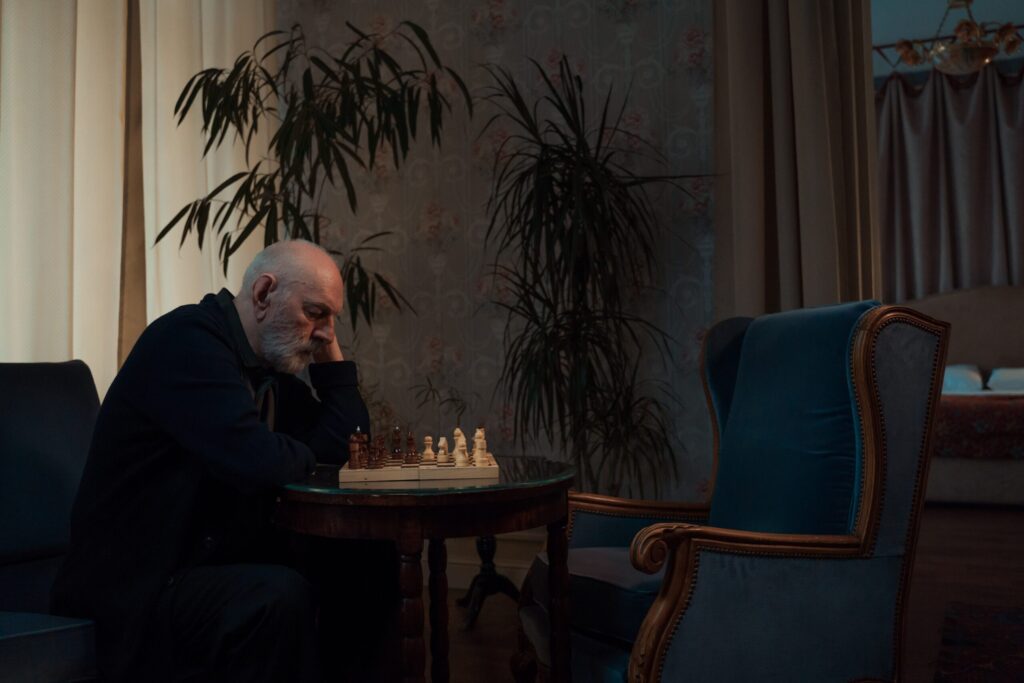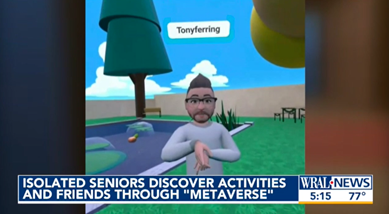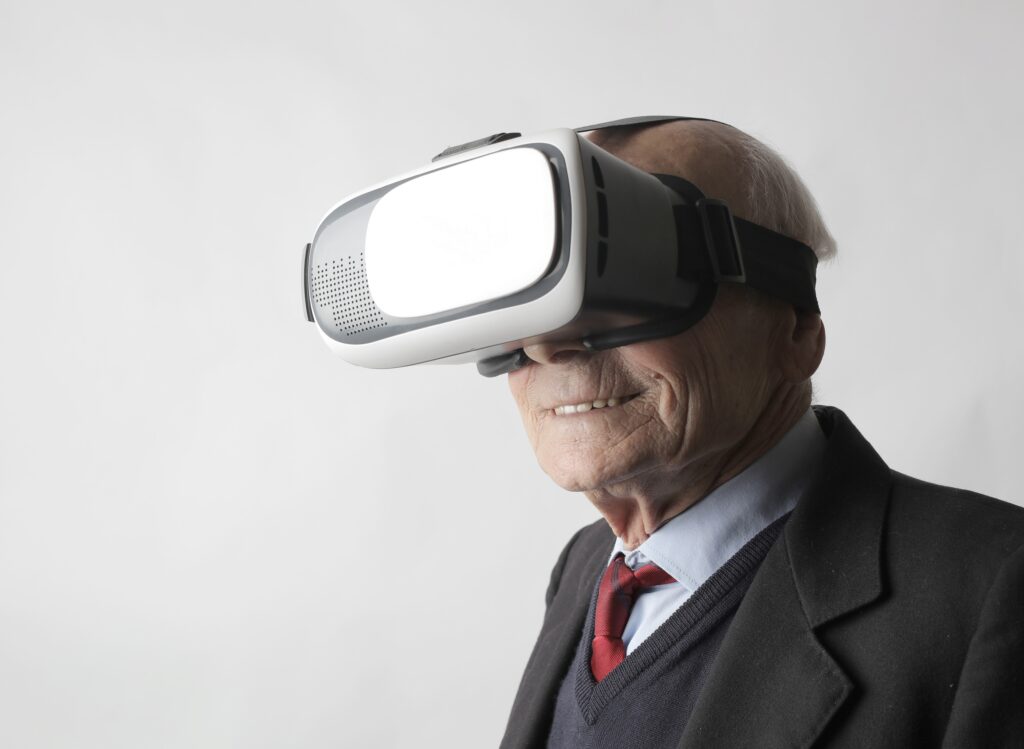How will Virtual Reality for Elderly Enhanced Well-Being?
The elderly and other vulnerable groups in society were hit particularly hard by the COVID-19 epidemic, which presented previously unseen issues. As lockdowns and limitations reduced opportunities for social engagement and hampered access to vital support networks, social isolation became a major problem. Because of the negative effects on their mental and physical health, the elderly often become socially isolated, and are difficult to reintegrate into mainstream society without new approaches. Here, virtual reality (VR) has emerged as a new powerful tool, radically altering how we interact with one another and the world.
Virtual reality (VR) technology has come a long way in recent years, becoming far more realistic, interactive, and user-friendly. The development of increasingly lifelike virtual worlds has opened up a wealth of opportunities for combating the social isolation of the elderly. The elderly can now discover new worlds, have important conversations, and find their place in the world all through virtual reality.
Furthermore, virtual reality equipment has become much more widely available. The price drop in VR headsets, the spread of VR content, and the expansion of VR-compatible devices have made it possible for the elderly to enjoy the benefits of this game-changing technology. Virtual reality (VR) experiences are no longer limited to experts in the field or hardcore enthusiasts. Virtual reality (VR) technology has made it possible for the elderly to experience new and thrilling adventures from the convenience of their own homes while interacting with real people from all over the world.
The future seems bright for virtual reality (VR) since the technology is only getting better and more affordable. Virtual reality holds immense potential for further enhancing the quality of life for seniors, from haptic feedback systems that provide a more immersive sensory experience to developments in motion tracking technology that boost user interaction. Virtual reality (VR) has the potential to alter many aspects of older people’s lives, including their social connections, therapeutic treatments, physical rehabilitation, and lifelong learning. One remarkable development in the realm of VR for seniors is the creation of the Thrive Pavilion.
Impact of Social Isolation on Wellbeing
Older people’s mental and physical health are severely impacted by their lack of social interaction. Anxiety, depression, and physical health problems like heart disease, obesity, and cognitive decline have all been linked to isolation. The restrictions brought on by the pandemic made things much worse, raising the stakes for things like social isolation and inactivity. For the sake of their health, older individuals must not be left alone and isolated.
VR as a Solution for Reducing Loneliness

Among older persons, virtual reality has emerged as a promising approach for minimizing social isolation and loneliness. Virtual reality (VR) experiences have been found to improve cognitive health and stimulate neuroplasticity (the brain’s ability to form new connections). Virtual reality (VR) activities that push participants’ imaginations, encourage exploration, and foster analysis have been shown to improve mental health and well-being.
Many virtual reality programs allow users to connect with others, learn new things, and engage in fun activities. Platforms like Thrive Pavilion give seniors a place to socialize online, host or attend online events, organize online reading clubs, listen to online lectures, and discover new online communities in a secure setting. Virtual reality (VR) provides older folks with not only a new way to communicate with one another, but also access to engaging activities like virtual sightseeing, art appreciation, and interactive gaming.
Initial Virtual Reality Research
Clinical Associate Professor Louanne Bakk and her group at the State University of New York, University at Buffalo, undertook pilot research to further investigate the advantages of VR for the elderly. Nine participants aged 65 and up experienced virtual reality using the Rendever VR platform in a group setting for the study. Virtual activities included visiting new places, returning to familiar places from childhood, and experiencing concerts and other cultural events. The study concluded that the dynamic and engaging immersive experiences given by VR programming helped participants feel less alone and more connected to their communities.
Constraints and Results
Virtual reality has a lot of potential, but it also has significant drawbacks and difficulties. To guarantee a good experience for the elderly, VR headsets’ comfort and usability difficulties, like discomfort, adaptations for eyeglass users, and even dizziness, must be resolved. To further ensure that VR technology is offered to a wider demographic, its accessibility and affordability must be improved.
Despite these obstacles, study after study has proved VR to be beneficial to the mental and emotional health of seniors. Mental and physical health, stress management, and a sense of community have all been shown to improve in surveys conducted before and after the intervention. Particularly effective in evoking pleasant emotional reactions and encouraging well-being, virtual reality (VR) experiences have been those that immerse participants in nature, culture, and art.
The Future of VR and Social Isolation
The further advancement of virtual reality technology has enormous promise to combat loneliness among the elderly. As technology evolves and becomes more user-friendly, virtual reality (VR) experiences may become more commonplace in assisted living facilities and private residences. Collaborations between VR studios and retirement communities will bring these adventures to more people. In addition, older folks’ input during the development and rollout of VR technology is crucial for catering to their unique requirements and preferences.
The Emergence of Thrive Pavilion’s Virtual Reality for the Elderly

K4Connect is a healthtech firm serving the senior housing sector, and their chief product officer, Robert Signore, noticed the severe isolation senior citizens were in during the epidemic. Signore’s favorable VR experiences motivated him to establish Thrive Pavilion in 2022, a virtual area for the elderly to socialize virtually. Thrive Pavilion is a relaxing hangout spot packed with fun group activities and immersive virtual reality tours created in collaboration with industry veteran Dean Tudor. The senior citizens found solace in the community center-like area, which restored a sense of community and participation that had been lost during the pandemic.
Vignettes: A VR Art Project to Share Memories
Through initiatives like Vignettes, Thrive Pavilion does more than just offer a place to meet new people and make friends. In this virtual reality art project, participants may bond through shared nostalgia while also generating unique, interactive narratives that bridge the gap between the past and the present. Virtual windows and immersive narratives bring to life childhood parades and historical events like the 1964 World’s Fair. A powerful method of emotional expression, vignettes help members feel a feeling of shared history and belonging.
Frequently Asked Questions
Is it possible that virtual reality could help reduce loneliness in the elderly?
There is evidence that VR can help reduce loneliness among the elderly. Virtual reality (VR) experiences have been shown to improve health, social bonds, and feelings of belonging.
Do older people face any special difficulties or restrictions when utilizing VR?
There are several restrictions and difficulties with using VR with seniors. Virtual reality (VR) headsets need to be made more user-friendly and comfortable, as well as more widely available and affordable. Constant innovation, however, is making VR less expensive and easier to use.
How can you use VR to boost senior citizens’ health and happiness?
The immersive environment of virtual reality facilitates communication, mental challenge, and exploration of new possibilities. Virtual reality (VR) has the potential to improve the lives of seniors by eliminating feelings of isolation and loneliness through the provision of virtual social spaces, immersive activities, and access to cultural and educational information.
Can all senior citizens enjoy virtual reality?
Although many seniors can benefit from virtual reality, it’s important to take each person’s preferences and physical capacities into account. It’s possible that some seniors will have trouble getting used to virtual reality or will find headsets uncomfortable. However, a wide variety of senior citizens can enjoy virtual reality with the right direction and assistance.
When it comes to helping elderly people who live alone, what role do you see virtual reality playing in the future?
It is anticipated that older folks will have greater access to virtual reality as technology improves. The future of virtual reality and its influence on reducing social isolation will be shaped in large part by partnerships between VR developers and senior living facilities, as well as the active participation of older individuals in the design process.
Pro Tips for Using Virtual Reality to Ease Social Isolation

- Pick a virtual reality headset that works for you: It’s important to think about things like comfort, usefulness, and compatibility while choosing a virtual reality headset. Especially if you wear spectacles, you should search for a headset with a padded headband and an adjustable head strap. Also, look at the many VR platforms out there and pick one that offers a wide variety of social and interactive activities.
- Join virtual reality (VR) forums and social groups online to improve your VR experience and make new friends who share your interests. If you’re interested in virtual reality (VR), joining a forum, Facebook group, or online community can help you meet other people who share your passion.
- Try out a variety of virtual reality (VR) experiences, not only games. Check out some online museums, performances, courses, and social gatherings. By exploring a variety of virtual reality (VR) experiences, you can find pursuits that speak to your passions, pique your curiosity, and bring you closer to other people.
- Take part in socially-focused group activities and events: Many VR platforms now include such options. Participate in online gatherings such as book clubs, meditation classes, virtual field trips, and lectures delivered by experts in their fields. These pursuits allow people to meet new people, have common experiences, and build friendships.
- Take advantage of VR’s ability to transfer you to new places and explore alien landscapes. Make use of this function by traveling to imaginary destinations you’ve always wanted to see or by revisiting places with special significance in your life. Taking a trip in your mind can give you a taste of adventure, pique your interest, and open the door to meaningful conversations with others about their travels.
- You can use websites like Vignettes to tell your own story and help others tell theirs. Participate in these initiatives to build something that will interest you and your fellow community members. By opening out about oneself, members of the VR community are more likely to make friends, start new discussions, and feel like they belong.
- Virtual reality (VR) paves the way for new kinds of group work and individual expression. Keep your eyes peeled for online group projects that would benefit from your artistic, performing, or teaching skills. Participating in group activities is beneficial for more than just avoiding solitude; it also develops creativity and a feeling of belonging.
- Although virtual reality provides a one-of-a-kind and immersive experience, it’s still crucial to keep in touch with people in the real world. Instead of replacing face-to-face communication, VR should be used to enhance it. Maintain a healthy social life by setting up regular video chats, online get-togethers, and in-person get-togethers with loved ones and neighbors.
- Be an advocate for older persons’ access to virtual reality technology as it develops and becomes more affordable. Inspire designers to create interfaces that are intuitive even for the elderly, as well as headsets that are comfortable and light. A more welcoming virtual reality environment can be developed with the help of input from the VR community.
- Immerse yourself in the fun and potential of VR; it’s a great way to learn about new places and meet new people. Travel for the sheer pleasure of seeing the globe, making new friends, and expanding your horizons. If you approach virtual reality (VR) with an open mind and a willingness to try new things, you may discover that it helps reduce feelings of loneliness and improves your quality of life.
VR Provides Great Benefits to Keep Seniors Connected
The psychological and social benefits of VR for seniors cannot be overstated. Research has shown that VR treatments can improve mental health, lower depression, and anxiety, and make life in general better. VR experiences improve cognitive function, memory recall, and neuroplasticity by creating a setting that is stimulating and interesting. Also, the immersive nature of VR can give seniors a sense of presence and control, which can make them feel more powerful and improve their self-esteem.
As virtual reality technology keeps getting better, it can become a more useful tool for older people. VR has the potential to change how we help older people with social isolation and general well-being by making it easier for them to talk to each other, giving them access to new environments, and improving their mental and social health. We need to keep researching, coming up with new ideas, and pushing for VR to be used by adults so that this life-changing technology can reach the people who need it most.
Virtual reality is a great way to help older people avoid social isolation by giving them chances to connect with others, get involved, and grow as people. VR has the potential to change the way seniors interact with each other, learn about new things, and improve their general health and well-being as technology keeps getting better and more people can use it. By using the power of virtual reality, we can create a future for older people that is more inclusive, connected, and fulfilling.






